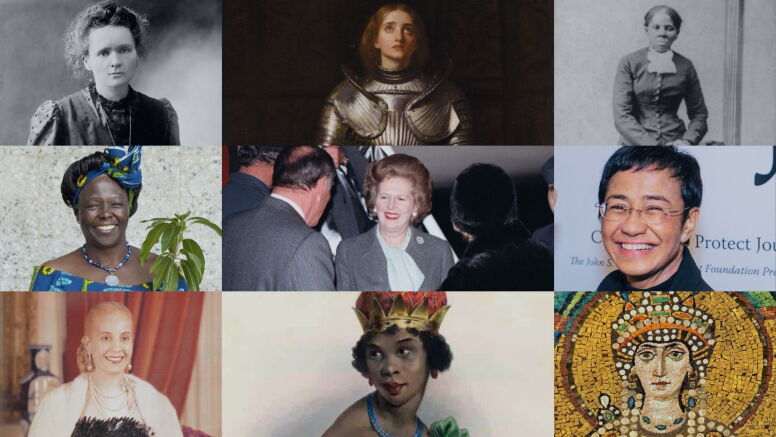News & Stories
The true grit of female leaders

A biography of Alexander the Great sparked Jan-Benedict Steenkamp’s interest in history’s greatest leaders when he was a kid, but it’s former British Prime Minister Margaret Thatcher who has had a big influence on his own leadership style.
“She succeeded where a long string of her predecessors, all male, did not,” says Steenkamp, Knox Massey Distinguished Professor of Marketing at UNC Kenan-Flagler Business School. “When she was told by those in her party that she needed to water down her views and tone down her language, she flat-out refused. She was decisive and unwavering as a leader. It was electrifying.”
Thatcher is one of 25 women across thousands of years of history profiled by Steenkamp in his soon-to-be-released book on leadership, “Warrior Queen Scientist Activist: Gritty Women Who Bent the Arc of History” (Xlibris, 2024).
History’s leadership lessons are often written by men about other men, but the reality is far more complex — and female. “Warrior” includes household names like Thatcher, Cleopatra, Joan of Arc and Queen Elizabeth I, but also those less well known, with legacies often overshadowed by their male counterparts.
There’s Zenobia, the third-century A.D. queen of the Roman province of Palmyra whose skill on the battlefield created an empire nearly as big as ancient Rome’s. There’s Virginia Hall, an American considered to be one of World War II’s most dangerous spies by the Gestapo, whose post-war career in the CIA was derailed by the machinations of male peers threatened by her success.
While Thatcher is a conservative icon, Steenkamp’s take on leadership is far from partisan. He also includes politically moderate former German Chancellor Angela Merkel as well as Harriet Tubman and an avowed communist, Angela Davis, who fought for civil rights and equality in very different ways.

Steenkamp
“These leaders had to be even tougher than the men because they had to first prove that as women, they could even be leaders in the first place. They began on an uneven playing field,” he says. “The women who succeeded made an impact that was even greater than that of men.”
The 25 women profiled lived during wildly different times and were motivated by everything from a duty to defend their people and advance society to wealth and power. They had a wide range of educational, cultural and ethnic backgrounds.
What they have in common is how they displayed distinctive leadership under intense pressure during the most defining moments of their lives — whether the result was triumph, disaster or something in between.
To Steenkamp, what resonates aren’t necessarily the specific actions taken by these female leaders. It’s their boldness and charisma, their ability to gain lasting loyalty, which we all can learn from today. Readers can learn more about their own mettle through an “Assessing Your Own Grit” test at the end of the book.
Determination and grit, Steenkamp shows, is genderless.
“I hope that any leader will be universally evaluated on the quality of their character and their competence, not their gender,” says Steenkamp. “I’m not writing this to be politically correct. I’m writing this about great leaders who did great deeds in world history. That’s what should resonate.”
“Warrior” is Steenkamp’s sixth book and his second on leadership lessons told using a historical perspective, and he worked closely with his friend, UNC ancient and medieval history Professor Fred Naiden, who provided feedback on every chapter.
It follows “Time to Lead: Lessons for Today’s Leaders from Bold Decisions that Changed History,” and became the basis for his popular Business School course, Leadership Lessons from History.
“These leaders had to be even tougher than the men because they had to first prove that as women, they could even be leaders in the first place. They began on that uneven playing field. The women who succeeded made an impact that was even greater than that of men.”
Steenkamp’s research led him to create a unique classification system for female leaders: hedgehogs, foxes and eagles. Hedgehogs act based on a clear vision for society, undaunted by tradition or criticism. Former First Lady of Argentina Eva Perón is a textbook hedgehog.
Foxes are the opposite, carefully crafting every single move, guided by pragmatism rather than overarching vision. That fits Merkel.
Eagles work toward a future vision that considers a society’s past; they’re flexible and unafraid to compromise. Njinga, a 17th-century southwest African ruler, soared as an eagle while fighting for her kingdom’s independence from Portugal.
Steenkamp further organizes female leaders into those who displayed impressive leadership during war, within politics and in the fight for human rights.
Deborah heroically led the nation of Israel from 1150 to 1125 B.C., organizing crushing defeats of their oppressors and proving herself a remarkable military strategist firmly in command, giving orders to her men directly and inspiring leaders like Joan of Arc.
Queen Isabella of Spain was a ruthless conqueror but insisted that those conquered by her kingdom should be treated fairly and kindly. The man almost always mentioned along with her name, King Ferdinand, was far more feckless than his dynamic queen.
The women in “Warrior” led fiercely and fearlessly despite the tremendous odds stacked against them. Merkel was elected with almost no political experience. She served as prime minister for 16 years, leading four different coalition governments and presiding over a dramatically improved German economy. Tubman risked certain death every day by helping other slaves escape the South through the Underground Railroad.

Steenkamp dedicates “Warrior” to his mother, wife and daughter.
Steenkamp doesn’t shy away from the fact that, as with legendary male leaders, these female leaders were human. Clara Barton, the tireless Civil War nurse who later co-founded the Red Cross, did not work well with others, male or female, to the point where her peers forced her out of the organization. Thatcher dedicated herself to breaking what she saw as the unchecked power of unions, earning her equal measures of reverence and disdain.
All were leaders very much of their times who faced timeless obstacles. Cleopatra’s enemies were quick to demean her through exaggerative stories of her promiscuity. Marie Curie, one of the most brilliant scientists in history, was usually overshadowed by her husband and research partner, Pierre, because he happened to be a man. That continued even after she received two Nobel Prizes, one shared with Pierre and one awarded to her solely. Curie found the strength to stand tall even as the dark cloud of sexism perpetually hovered.
“I wanted to show the ubiquity of female leadership across different endeavors,” says Steenkamp. “There is a very important message of hope here as well: We can see that a woman doesn’t have to fit in a particular kind of behavior to succeed. She can do it alone or with others, just like male leaders. But she will need to have grit, as do men. That’s inspiring to me.”
Steenkamp is also inspired by the three most important women in his life. He dedicates the book to his mother, Constance Steenkamp; his wife, the renowned marketing scholar Valarie Zeithaml, and his daughter, Iris Steenkamp, a marketing professor at Bocconi University in Milan.
“They have all shaped me in different ways,” he says. “But especially through my mother, I learned that in every situation what’s paramount is being truthful to my values. Do not compromise on what you hold dear, even if it costs you. That is something that I’ve always tried to do, wherever I go and whenever I lead.”